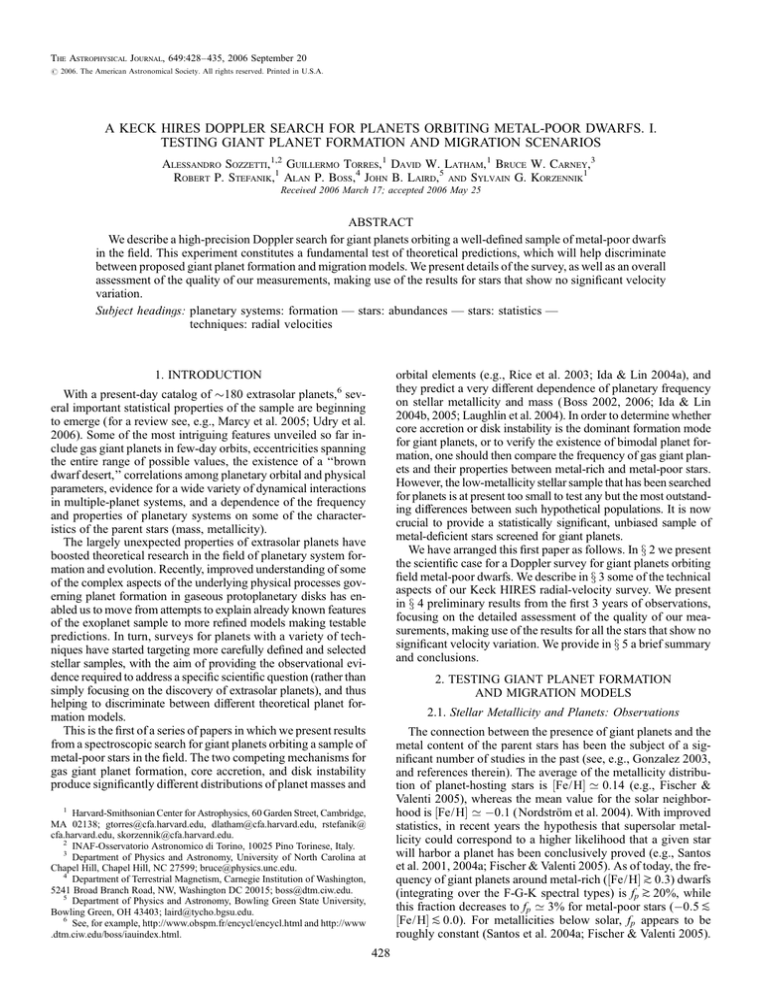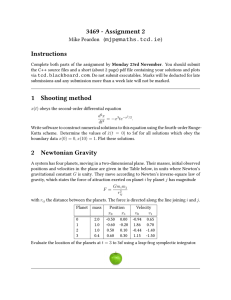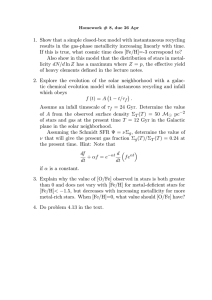
The Astrophysical Journal, 649:428–435, 2006 September 20
# 2006. The American Astronomical Society. All rights reserved. Printed in U.S.A.
A KECK HIRES DOPPLER SEARCH FOR PLANETS ORBITING METAL-POOR DWARFS. I.
TESTING GIANT PLANET FORMATION AND MIGRATION SCENARIOS
Alessandro Sozzetti,1,2 Guillermo Torres,1 David W. Latham,1 Bruce W. Carney,3
Robert P. Stefanik,1 Alan P. Boss,4 John B. Laird,5 and Sylvain G. Korzennik1
Received 2006 March 17; accepted 2006 May 25
ABSTRACT
We describe a high-precision Doppler search for giant planets orbiting a well-defined sample of metal-poor dwarfs
in the field. This experiment constitutes a fundamental test of theoretical predictions, which will help discriminate
between proposed giant planet formation and migration models. We present details of the survey, as well as an overall
assessment of the quality of our measurements, making use of the results for stars that show no significant velocity
variation.
Subject headingg
s: planetary systems: formation — stars: abundances — stars: statistics —
techniques: radial velocities
1. INTRODUCTION
orbital elements (e.g., Rice et al. 2003; Ida & Lin 2004a), and
they predict a very different dependence of planetary frequency
on stellar metallicity and mass ( Boss 2002, 2006; Ida & Lin
2004b, 2005; Laughlin et al. 2004). In order to determine whether
core accretion or disk instability is the dominant formation mode
for giant planets, or to verify the existence of bimodal planet formation, one should then compare the frequency of gas giant planets and their properties between metal-rich and metal-poor stars.
However, the low-metallicity stellar sample that has been searched
for planets is at present too small to test any but the most outstanding differences between such hypothetical populations. It is now
crucial to provide a statistically significant, unbiased sample of
metal-deficient stars screened for giant planets.
We have arranged this first paper as follows. In x 2 we present
the scientific case for a Doppler survey for giant planets orbiting
field metal-poor dwarfs. We describe in x 3 some of the technical
aspects of our Keck HIRES radial-velocity survey. We present
in x 4 preliminary results from the first 3 years of observations,
focusing on the detailed assessment of the quality of our measurements, making use of the results for all the stars that show no
significant velocity variation. We provide in x 5 a brief summary
and conclusions.
6
With a present-day catalog of 180 extrasolar planets, several important statistical properties of the sample are beginning
to emerge (for a review see, e.g., Marcy et al. 2005; Udry et al.
2006). Some of the most intriguing features unveiled so far include gas giant planets in few-day orbits, eccentricities spanning
the entire range of possible values, the existence of a ‘‘brown
dwarf desert,’’ correlations among planetary orbital and physical
parameters, evidence for a wide variety of dynamical interactions
in multiple-planet systems, and a dependence of the frequency
and properties of planetary systems on some of the characteristics of the parent stars (mass, metallicity).
The largely unexpected properties of extrasolar planets have
boosted theoretical research in the field of planetary system formation and evolution. Recently, improved understanding of some
of the complex aspects of the underlying physical processes governing planet formation in gaseous protoplanetary disks has enabled us to move from attempts to explain already known features
of the exoplanet sample to more refined models making testable
predictions. In turn, surveys for planets with a variety of techniques have started targeting more carefully defined and selected
stellar samples, with the aim of providing the observational evidence required to address a specific scientific question (rather than
simply focusing on the discovery of extrasolar planets), and thus
helping to discriminate between different theoretical planet formation models.
This is the first of a series of papers in which we present results
from a spectroscopic search for giant planets orbiting a sample of
metal-poor stars in the field. The two competing mechanisms for
gas giant planet formation, core accretion, and disk instability
produce significantly different distributions of planet masses and
2. TESTING GIANT PLANET FORMATION
AND MIGRATION MODELS
2.1. Stellar Metallicity and Planets: Observations
The connection between the presence of giant planets and the
metal content of the parent stars has been the subject of a significant number of studies in the past (see, e.g., Gonzalez 2003,
and references therein). The average of the metallicity distribution of planet-hosting stars is ½Fe/H ’ 0:14 (e.g., Fischer &
Valenti 2005), whereas the mean value for the solar neighborhood is ½Fe/ H ’ 0:1 ( Nordström et al. 2004). With improved
statistics, in recent years the hypothesis that supersolar metallicity could correspond to a higher likelihood that a given star
will harbor a planet has been conclusively proved (e.g., Santos
et al. 2001, 2004a; Fischer & Valenti 2005). As of today, the frequency of giant planets around metal-rich (½Fe/H k 0:3) dwarfs
(integrating over the F-G-K spectral types) is fp k 20%, while
this fraction decreases to fp ’ 3% for metal-poor stars (0:5 P
½Fe/H P 0:0). For metallicities below solar, fp appears to be
roughly constant (Santos et al. 2004a; Fischer & Valenti 2005).
1
Harvard-Smithsonian Center for Astrophysics, 60 Garden Street, Cambridge,
MA 02138; gtorres@cfa.harvard.edu, dlatham@cfa.harvard.edu, rstefanik@
cfa.harvard.edu, skorzennik@cfa.harvard.edu.
2
INAF-Osservatorio Astronomico di Torino, 10025 Pino Torinese, Italy.
3
Department of Physics and Astronomy, University of North Carolina at
Chapel Hill, Chapel Hill, NC 27599; bruce@physics.unc.edu.
4
Department of Terrestrial Magnetism, Carnegie Institution of Washington,
5241 Broad Branch Road, NW, Washington DC 20015; boss@dtm.ciw.edu.
5
Department of Physics and Astronomy, Bowling Green State University,
Bowling Green, OH 43403; laird@tycho.bgsu.edu.
6
See, for example, http://www.obspm.fr/encycl/encycl.html and http://www
.dtm.ciw.edu/boss/iauindex.html.
428
KECK-HIRES DWARF PLANET SEARCH. I.
Many authors have debated whether the observational evidence is an indicator of primordial high metallicity in the planethost stellar sample (Santos et al. 2001; Reid 2002), or if the trend
with [ Fe/H] could be due to pollution by ingested planetary
material ( Laughlin 2000; Gonzalez et al. 2001; Israelian et al.
2001; Murray & Chaboyer 2002). The idea of pollution is losing
credit among the scientific community, primarily due to the lack
of any correlation between [Fe/H] and effective temperature TeA ,
or convective envelope mass Mconv , for the planet host sample
(e.g., Pinsonneault et al. 2001; Fischer & Valenti, 2005; Santos
et al. 2003, 2004a, and references therein). Results on this specific issue are not yet conclusive, however. For example, Vauclair
(2004) has recently pointed out that the absence of an [Fe/H]Mconv correlation does not automatically imply that stars with
planets have not been polluted.
Furthermore, theoretical calculations (Montalbán & Rebolo
2002; Boesgaard & King 2002) suggest that detection of anomalous abundances of rare elements such as lithium (Li) or beryllium (Be) could be interpreted as evidence for recent accretion of
planets onto the atmosphere of a star. The abundances of Li isotopes in the spectral region around the 6707 8 line in planet-host
stars have recently been investigated by several authors (Gonzalez
& Laws 2000; Ryan 2000; Israelian et al. 2001, 2003, 2004;
Reddy et al. 2002; Mandell et al. 2004), and similar studies have
been conducted for the Be ii lines at 3130 8 and 3131 8 (Garcı́a
López & Pérez de Taoro1998; Deliyannis et al. 2000; Santos
et al. 2002, 2004b). While the presence of the 6Li isotope has
actually been detected in some planet-harboring stars ( Israelian
et al. 2001, 2003, 2004; Laws & Gonzalez 2001), suggesting that
accretion of planetary material can indeed take place in some
stars, generally stars with planets have normal light-element abundances, typical of field stars. It thus seems unlikely that pollution
effects can be responsible for the overall metallicity enhancement
of the planet-host stellar sample.
In addition, analyses of over a dozen other elements have been
carried out in recent years (Santos et al. 2000; Gonzalez et al.
2001; Smith et al. 2001; Takeda et al. 2001; Sadakane et al. 2002;
Zhao et al. 2002; Bodaghee et al. 2003; Ecuvillon et al. 2004a,
2004b, 2006b; Beirão et al. 2005; Gilli et al. 2006; Sozzetti et al.
2006), and the general evidence is that the abundance distributions in stars with planets are an extension of the observed behavior for [Fe/H], a result quantified by trends of decreasing
[X/Fe] with decreasing [ Fe/H]. The absence of any statistically
significant trend of metallicity [X/H] with condensation temperature Tc (e.g., Sozzetti et al. 2006; Ecuvillon et al. 2006a;
Gonzalez 2006) is one more piece of circumstantial evidence
that the best explanation for the metallicity excess in stars with
planets is that the enhanced [Fe/H] is primordial in nature.
Several studies have also focused on possible correlations between stellar metallicity and planet properties. While no significant trend was found between [Fe/H] and planet mass or orbital
eccentricity (e.g., Udry et al. 2002; Santos et al. 2001, 2003;
Fischer et al. 2002), evidence (albeit weak) for a correlation between the metallicity of planet-harboring stars and the orbital
periods P of the planets has been pointed out (e.g., Sozzetti 2004,
and references therein; Santos et al. 2006). This correlation is
highlighted by an excess of close-in planets, on few-day orbits,
around the metal-rich (½Fe/ H k 0:0) sample of planet hosts.
2.2. Stellar Metallicity and Planets: Theory
Within the framework of the scenario of gas giant planet
formation by core accretion (e.g., Lissauer 1993; Pollack et al.
1996; Alibert et al. 2004), recent studies have successfully re-
429
produced the strong dependence of planetary frequency on
stellar metallicity, in qualitatively good agreement with the observed trend ( Kornet et al. 2005; Ida & Lin 2004b). The probability of forming giant planets according to the disk instability
model (e.g., Boss 1997, 2000; Mayer et al. 2004), however, is
remarkably insensitive to the primordial surface density of solids
of the protoplanetary disk (Boss, 2002; Rice et al. 2003); thus
planet occurrence should not be hampered around metal-poor
stars. On the one hand, the observed trend suggests that giant
planet formation by core accretion predominates in the metalrich regime (½Fe/H k 0:0). On the other hand, fp appears to be
rather flat in the metal-poor regime (½Fe/H P 0:0). The possible
evidence for bimodality of the planet frequency distribution as a
function of metallicity (Santos et al. 2004a; Fischer & Valenti
2005) suggests the existence of two different mechanisms for
forming gas giant planets. However, due to the low numbers of
metal-poor stars (½Fe/H P0:5) surveyed to date, no definitive
conclusion can be drawn, except that maybe both mechanisms
operate ( Beer et al. 2004).
If real, several possible explanations can be put forth for the
existence of a P-[Fe/H] correlation. For example, migration rates
might be slowed down in metal-poor protoplanetary disks (Livio
& Pringle 2003; Boss 2005), although the predicted dependence of migration timescales on [Fe/H] appears to be somewhat
weak. The correlation may also arise as a consequence of longer
timescales for giant planet formation around metal-poor stars,
and thus reduced migration efficiency before the disk dissipates
( Ida & Lin 2004b; Alibert et al. 2005). Another possibility
(Santos et al. 2006) is related to planetary internal-structure arguments: if planets formed in low-metallicity disks have small
rocky cores (e.g., Pollack et al. 1996; Ida & Lin 2004b), their low
density might hamper survival against evaporation (Baraffe et al.
2004; Lecavelier des Etangs et al. 2004) once they have migrated
to very close-in orbits. However, even in this case small-number
statistics in the low-metallicity regime prevent one from reaching a clear conclusion.
One way or another, in order to unambiguously determine the
role of metallicity in gas giant planet formation (for example, is
fp a truly monotonic function of [Fe/H], or is planetary frequency
constant in the metal-poor regime?), and consequently discriminate between proposed explanations for the observed trends in
the data, it is crucial to provide a statistically significant, unbiased
sample of metal-poor stars screened for giant planets.
2.3. Searching for Planets around Field Metal-Poor Stars
The absence of short-period (P 8:3 days) transiting planets
in the moderately metal-deficient (½Fe/H ’ 0:7) globular
cluster 47 Tucanæ has been used by Gilliland et al. (2000) and
Weldrake et al. (2005) to argue that low-metallicity stars are less
likely to harbor giant planets. However, the claims by these
authors suffer from some ambiguity, because in the cluster core
investigated by Gilliland et al. (2000) with HST transit photometry, crowding could play a significant role in giant planet formation, migration, and survival (e.g., Davies & Sigurdsson
2001; Bonnell et al. 2001; Hurley & Shara 2002; Fregeau et al.
2006). The outer regions of the cluster monitored by Weldrake
et al. (2005) are less affected by crowding. However, the lower
occurrence rate of hot Jupiters in a metal-poor environment does
not rule out the existence of a population of giant planets at wider
radii. Indeed, this possibility has recently been supported by
the findings of Sigurdsson et al. (2003), who, using HST data,
were able to infer a mass of a few Jupiter masses for the third,
long-period component orbiting the white dwarf-pulsar system
430
SOZZETTI ET AL.
Vol. 649
B162026 in the globular cluster M4, 5 times more metal-poor
than 47 Tuc. Their results provide the first evidence for planet
formation in very metal-poor environments. In light of the M4
announcement, the 47 Tuc results could be reinterpreted as follows: dynamical disruption in dense clusters is not sufficient
to completely destroy any planetary population, and the lack of
transiting planets on short-period orbits might be due to other
processes, such as a metallicity dependence in the migration
mechanism, or suppression of migration ( but not formation) in
globular clusters.7
By addressing the field population of metal-poor stars directly,
it is then possible to eliminate dynamical interactions in dense stellar environments as a possible source of interference with planet
formation, or with migration to close-in orbits, or with planet
survival.
3. THE KECK HIRES DOPPLER SURVEY
OF METAL-POOR DWARFS
In 2003, we began a high-precision radial-velocity survey of
200 metal-poor stars, using HIRES on the Keck I telescope
( Vogt et al. 1994) and its I2 gas absorption cell as the reference
velocity metric ( Butler et al. 1996). The goal of this project is
to carry out an initial reconnaissance for gas giant planets orbiting within 1 AU of a statistically significant sample of lowmetallicity dwarfs.
The sample has been drawn from the Carney-Latham and Ryan
samples of metal-poor, high-velocity field stars (e.g., Carney et al.
1994; Ryan 1989; Ryan & Norris 1991). The initial combined
database totaled 1558 objects. A number of selection criteria
have been adopted in order to finalize our list of targets. First, a
key advantage of the Carney-Latham and Ryan samples is that
we have monitored the radial velocities of the stars in these
samples, most for more than 3000 days, using the CfA digital
speedometers ( Latham 1992). This has allowed us to identify
most of the stars with stellar companions that would interfere
with the formation or survival of planets in the habitable zones
(Carney et al. 2001; Latham et al. 2002). All stars included in the
final list of targets showed no sign of velocity variation at the 0.5
to 1.0 km s1 level. Second, significant chromospheric activity
(quantified, for example, through the chromospheric emission
0
) and large values of stellar rotational velocity v sin i
ratio RHK
should be avoided, as they constitute sources of intrinsic radial
velocity ‘‘jitter’’ that can mask, and sometimes even mimic, the
presence of orbital reflex motion due to planetary mass companions (Saar et al. 1998; Santos et al. 2000; Queloz et al. 2001;
Paulson et al. 2004). Fortunately, old stars have the advantage of
rotating slowly and having low levels of chromospheric activity.
All of the stars in our sample exhibit rotational velocities
v sin i 10 km s1 , and most have rotations below the resolution limit of the CfA digital speedometers (8.5 km s1 ), so that a
value of v sin i could not be determined. Thus, we do not expect
velocity jitter due to astrophysical phenomena to be a problem
for this sample.
7
Notably, the lack of any apparent correlation in the plane defined by minimum mass Mp sin i and orbital period P for planets in binary and triple stellar
systems (as opposed to the observed Mp sin i P correlation in the case of planets
orbiting single stars) is interpreted as evidence for enhanced migration efficiency
for planets formed in stellar systems ( Zucker & Mazeh 2002; Udry et al. 2003;
Eggenberger et al. 2004). However, the birthplaces for such systems are stellar
groups and clusters with much lower stellar densities than globular clusters.
Thus, both the impact on planet formation and migration efficiency as well as the
evolutionary history of dynamical interactions are likely not the same in these
two different environments (e.g., Davies & Sigurdsson 2001; Adams et al. 2006).
Fig. 1.—Degradation in the radial-velocity precision RV as a function of
stellar metallicity, effective temperature, and gravity, for fixed exposure time.
The zero point of RV for solar values of [ Fe/ H ], TeA , and log g is arbitrarily
scaled to 10 m s1 .
However, metal-poor stars have weak absorption lines in
comparison to their solar-metallicity counterparts. The lines also
grow weaker as the effective temperature rises. Furthermore,
very metal-poor stars are rare, and therefore they tend to be distant and faint. In order to characterize the behavior of the radial
velocity precision RV as a function of stellar metallicity, effective temperature TeA , and visual magnitude V (assuming nonrotating, inactive stars), we have run simulations utilizing the CfA
library of synthetic stellar spectra (e.g., Nordström et al. 1994;
Latham et al. 2002). We show in Figure 1 how RV degrades as a
function of [ Fe/H] and TeA , assuming a fixed exposure time and
a typical measurement precision of 10 m s1 for ½Fe/ H ¼ 0:0.
For a solar-type star, ½Fe/ H ¼ 1:0 corresponds to a degradation in RV of a factor 2, while for a significantly cooler star,
with a more complex spectrum,8 the effect is less severe (in addition, surface gravity constitutes only a higher order effect). This
result confirms the empirical findings of Santos et al. (2003) and
Fischer & Valenti (2005), based on the analyses of the achieved
velocity precision as a function of metallicity carried out with
the stellar databases of their respective Doppler planet surveys.
Those studies were aimed at ruling out possible observational
biases that might contribute to the observed correlation between
fp and [Fe/H]. In both cases, Santos et al. (2003) and Fischer &
Valenti (2005) conclude that, given the typical single-measurement precision RV ’ 3 5 m s1 achieved for bright objects
(typically V P 8:0), a velocity degradation of a factor 1.5–2 does
not imply that a fraction of the giant planets orbiting lowmetallicity stars might have gone undetected (at least in the
orbital period range currently covered by Doppler surveys).
However, not many bright metal-poor stars (0:5 P ½Fe/H P
0:0) are found in the solar neighborhood (d P 50 pc). In order
to create a statistically significant database ( hundreds of stars)
of metal-poor (½Fe/H P 0:5) dwarfs, one must then include
more distant, and fainter, objects. For the purpose of optimizing
the trade off between number of objects surveyed and total observing time required, we have refined our sample of metalpoor dwarfs from the Carney-Latham and Ryan surveys by
adopting magnitude and temperature cut offs (V 12:0 and
8
The velocity information content depends on the mean absolute value of the
slope of the spectrum, which increases for later spectral types (e.g., Butler et al.
1996; Bouchy et al. 2001).
No. 1, 2006
431
KECK-HIRES DWARF PLANET SEARCH. I.
Fig. 3.—The rms velocity distribution for 80% of the stars in our sample,
for which uniform temporal coverage has been obtained (see text for details).
Objects exhibiting significant radial velocity variations (>30 m s1 ) are not
shown.
TeA 6000 K, respectively), and by selecting objects in the
metallicity range 2:0 ½Fe/ H 0:6.
In the empirical error model we have obtained using the simulations with the CfA database of synthetic spectra, the radialvelocity uncertainty is
RV ¼
Fig. 2.—Distributions of visual magnitudes (top), distances from the Sun
(center), and metallicities (bottom) for a sample of 278 metal-poor stars selected
with the criteria detailed in the text. For comparison, the same distributions for a
large sample of 119 planet hosts are also shown (data from Santos et al. 2004a,
2005; Sozzetti et al. 2004).
t0
texp
10:0
(V V0 )=2:5
1=2
F(½Fe/H; TeA );
ð1Þ
where F(½Fe/H; TeA ) is an empirical function of temperature
and metallicity based on the simulation results shown in Figure 1, and t0 and V0 are reference integration time and magnitude for a star with the temperature and metallicity of the Sun.
Based on our experience with solar neighborhood G dwarfs
observed with HIRES for the G Dwarf Planet Search Program
( Latham 2000), we have set a threshold of 20 m s1 precision
for planet detection, and computed the relative exposure times
needed to achieve such precision, for each star in our sample.
Furthermore, we decided to limit the maximum exposure times
to 15 minutes, to minimize uncertainties in the barycentric correction. We show in Figure 2 the distribution of [ Fe/ H], V, and
distance estimates (for those objects with Hipparcos parallaxes,
photometric otherwise) for the sample of 278 metal-poor stars
derived after adopting all the selection criteria described above.
In order to highlight the different ranges of metallicity, magnitude, and distance spanned by our survey, the same distributions
for a large fraction of the present-day sample of planet hosts are
also shown. Given that the average stellar mass in our sample
is 0.69 M , setting a velocity precision threshold at 20 m s1
is sufficient to detect (at the 5 level ) velocity variations of
planetary companions with minimum mass in the average range
0:59MJ Mp sin i 2:75MJ , or higher, for orbital periods in
the range 0:01 P 1 yr.
432
SOZZETTI ET AL.
Fig. 4.—The rms velocity residuals as a function of the timespan of the
observations. Overplotted are the median (large filled circles) and standard deviation in 500 day bins. Variables with rms >30 m s1 are not taken into account.
Finally, if it turns out to be true that planets did not form
around metal-poor dwarfs, then we need to observe a largeenough sample that a null result, i.e., no detections, is significant. The rate at which giant planets with orbits inside 1 AU are
being discovered by radial velocities appears to be about P ’
3% (e.g., Marcy et al. 2005). In order for the failure to detect any
planetary companions to be significant at the 3 level (corresponding to a probability of 0.0027), we need to survey a sample of N stars, where (1 P)N ¼ 0:0027, which is satisfied for
N ¼ 194. We therefore defined our final target list by selecting a
subset of 200 metal-poor stars out of the abovementioned larger
sample of 278 objects, which will eventually provide a robust 3 null result in the case of no detections.
4. PRELIMINARY RESULTS
Our observing program has been awarded an average of two
Keck HIRES nights per semester, starting in early 2003. Good
Vol. 649
Fig. 6.—Histogram of all the velocity residuals (including variables) normalized by their formal uncertainties. The dotted line represents a reference
Gaussian distribution with zero mean and unit dispersion. If, for example, internal errors are over or underestimated, this effect should show up as distortions
in the distribution. The width of the distribution is very close to unity, indicating
the absence of significant biases. Formal errors are a good estimate of the true
underlying uncertainties.
temporal coverage is thus a serious issue, as such a scheduling
of the observations is good for sampling long-period radialvelocity variations, but rather poor for identifying possible shortperiod variables. We have tried to obtain at least three velocity
measurements per star per year, with at least one set of back-toback observations (taken in two consecutive nights), in order to
mitigate our bias toward poor sampling (and thus significant
aliasing and ambiguities) at short orbital periods.
The first important step is to provide an assessment of the longterm stability of the velocity zero point and single-measurement
precision achieved for planet detection, in light of the predicted
exposure times needed to reach RV ¼ 20 m s1 . Our analysis
pipeline incorporates the full modeling of temporal and spatial
variations of the HIRES instrumental profile (Valenti et al. 1995),
Fig. 5.—Radial velocity scatter (excluding variables with rms 30 m s1 ) as a function of [Fe/ H ] (left), TeA (center), and V (right). Based on a rank-correlation test,
the probability of no correlation in the three cases is 0.61, 0.14, and 0.09, respectively (i.e., no significant correlation is present).
No. 1, 2006
KECK-HIRES DWARF PLANET SEARCH. I.
433
Fig. 7.—Observed relative velocities RV for a sample of stars in our program. The top two panels show objects with constant velocity to 10 m s1 over a time
span of 8 yr, after combining observations taken in the context of the G Dwarf Planet Search program ( Latham 2000). The mean rms of the stars shown in the other
panels is 9 m s1 , the same as the average of the full sample (excluding variable stars). Comparable precision is achieved over ranges of 1000 K in TeA , 4 mag, and 1 dex
in metallicity.
similar to the method adopted by other groups (e.g., Butler et al.
1996; Korzennik et al. 2000; Cochran et al. 2002). Spectral
modeling of each echelle order containing I2 lines is carried out
independently, and internal uncertainties for each observation
are computed from the scatter of the velocities around the mean.
This analysis technique has allowed us to significantly improve
on our initial estimates of achievable radial velocity precision.
In Figure 3, we show the histogram of the rms velocity residuals
for about 80% of our sample, for which we have achieved substantially uniform temporal coverage (typically 5–6 observations per star, with at least two back-to-back exposures, over a
time span of at least a year). The rms velocity residuals distri-
bution of the full sample (excluding variables with rms 30 m s1 )
averages 9 m s1 . In Figure 4, we show the rms velocity residuals as a function of the timespan of the observations. Overplotted are the median and standard deviation in 500 day bins
(again, variable stars are not included ). As about two dozen of
the stars in our sample are in common with the G dwarf planet
survey of Latham (2000), we could establish the longterm stability of the velocity zero-point over timescales of up to 8 years.
This demonstrates the true radial-velocity precision we are obtaining on the sample of metal-poor stars, with a significant improvement of over a factor of 2 with respect to the targeted
20 m s1 single-measurement precision.
434
SOZZETTI ET AL.
The exposure times predicted by the model derived from the
simulations with the CfA library of stellar spectra are determined
as a function of [ Fe/H], TeA , and V. However, our program stars
are up to 3–4 mag fainter and up to >100 times more metal poor
than typical targets of Doppler planet searches. One possible matter of concern would then be the evidence of systematic trends in
the velocity scatter as a function of these three parameters. However, as shown in Figure 5, no clear rms velocity trends as a function of [Fe/H], TeA , and V are present. This gives us confidence
that the model we developed for the dependence of the radialvelocity precision on the above parameters is robust.
A more quantitative, and challenging, test to demonstrate that
the character of our errors is well understood can be carried out by
studying the distribution of the velocity residuals compared to
their formal uncertainties. We define the ratio RV/RV as the
difference between the velocity values and their mean value for
each star, divided by their estimated uncertainties. In the ideal case,
if internal errors are an accurate tracer of the actual uncertainties in
the measurements, this ratio should have a Gaussian distribution
with zero mean and unit dispersion. Discrepancies between predicted and actual errors should be reflected in measurable departures from Gaussianity. We show in Figure 6 the histogram of the
ratio RV/RV for all our program stars (including variables).
Overplotted is a reference Gaussian with zero mean and unit dispersion. The RV/RV distribution is very close to Gaussian,
with no apparent positive or negative biases. Slightly elevated
wings (6% of the velocity differences are larger than 5 ) indicate the presence of either non-Gaussian outliers or true variables. The result shown in Figure 6 demonstrates that our internal
errors are realistic. The fundamental conclusion is that we achieve
sufficient radial-velocity precision in our sample to clearly detect
Jupiter-mass objects within 1 AU of metal-deficient dwarfs.
We show in Figure 7 some examples of our velocity measurements of metal-deficient dwarfs. The top two panels show
results for two of the stars ( HD 157089 and G68-30) in common
between our survey and the G Dwarf Planet Search program
( Latham 2000). These objects are constant to 10 m s1 over a
timescale of 8 yr. The examples of velocity timeseries shown
in the other panels of Figure 7 cover a range of 1000 K in TeA ,
4 mag, and ’1 dex in [ Fe/H]. The rms of the observations
range between 6 and 11 m s1 , with an average of 9 m s1 .
While a large fraction of our sample shows no significant velocity variations over the time span of the observations, a number
of objects do exhibit velocity variability indicative of the presence of companions. A thorough analysis of our planet detectability thresholds and a detailed presentation of all our velocity
measurements will be the subject of our second paper.
Vol. 649
5. CONCLUSIONS
One way to distinguish between proposed models of gas giant
planet formation is to confirm or rule out, on an observational
basis, their different predictions for planet frequency fp as a function of the metallicity of the stellar hosts. To address this issue,
we have undertaken a Doppler search for giant planets within
1 AU of a sample of 200 metal-deficient (2:0 ½Fe/H 0:6)
dwarfs in the field. This is the sample size needed to provide a
statistically significant result (at the 3 level ) in the case of no
detections. Using the Keck I telescope and its HIRES spectrograph, we have achieved a longterm radial-velocity precision
of 9 m s1 , independently of [Fe/H] and TeA , and for stars 2–
4 mag fainter than the targets for most other radial-velocity
planet surveys. We have provided convincing evidence that our
internal error estimates are reliable, and thus demonstrated that
we achieve sufficient radial-velocity precision in our sample to
clearly detect Jupiter-mass objects within 1 AU of metal-deficient
dwarfs. A number of objects with significant radial-velocity trends
have been identified, for which we plan to perform followup observations. At the conclusion of our Doppler survey, we will be
able to place useful upper limits on the existence of planetary companions of given mass and period around metal-poor stars, and we
will then compare the frequency of gas giant planets and their
properties in metal-rich and metal-poor stars. These issues will be
addressed in future papers.
A. S. acknowledges support from the Keck PI Data Analysis
Fund (JPL 1267110). G. T. acknowledges partial support for this
work from NASA Origins grant NNG04LG89G. J. L. is partially
supported by an NSF grant AST-0307340. B. C. gratefully acknowledges support from an NSF grant AST-0305431. It is a
pleasure to acknowledge Mike Kurtz for very stimulating discussions. Special thanks are due to Dimitar Sasselov for lending
initial impetus and support to this investigation. The data presented herein were obtained at the W. M. Keck Observatory, which is operated as a scientific partnership among the
California Institute of Technology, the University of California,
and the National Aeronautics and Space Administration. The
Observatory was made possible by the generous financial support of the W. M. Keck Foundation. The authors wish to recognize and acknowledge the very significant cultural role and
reverence that the summit of Mauna Kea has always had within
the indigenous Hawaiian community. Without their generous
hospitality, the Keck observations presented here would not
have been possible.
REFERENCES
Adams, F. C., Proszkow, E. M., Fatuzzo, M., & Myers, P. C. 2006, ApJ, 641, 504
Carney, B. W., Latham, D. W., Laird, J. B., & Aguilar, L. A. 1994, AJ, 107, 2240
Alibert, Y., Mordasini, C., & Benz, W. 2004, A&A, 417, L25
Carney, B. W., Latham, D. W., Laird, J. B., Grant, C. E., & Morse, J. A. 2001,
Alibert, Y., Mordasini, C., Benz, W., & Winisdoerffer, C. 2005, A&A, 434, 343
AJ, 122, 3419
Baraffe, I., Selsis, F., Chabrier, G., Barman, T. S., Allard, F., Hauschildt, P. H.,
Cochran, W. D., Hatzes, A. P., & Paulson, D. B. 2002, AJ, 124, 565
& Lammer, H. 2004, A&A, 419, L13
Davies, M. B., & Sigurdsson, S. 2001, MNRAS, 324, 612
Beer, M. E., King, A. R., Livio, M., & Pringle, J. E. 2004, MNRAS, 354, 763
Deliyannis, C. P., Cunha, K., King, J. R., & Boesgaard, A. M. 2000, AJ, 119,
Beirão, P., Santos, N. C., Israelian, G., & Mayor, M. 2005, A&A, 438, 251
2437
Bodaghee, A., Santos, N. C., Israelian, G., & Mayor, M. 2003, A&A, 404, 715
Ecuvillon, A., Israelian, G., Santos, N. C., Mayor, M., Garcı́a López, R. J., &
Boesgaard, A. M., & King, J. R. 2002, ApJ, 565, 587
Randich, S. 2004a, A&A, 418, 703
Bonnell, I. A., Smith, K. W., Davies, M. B., & Horne, K. 2001, MNRAS, 322,
Ecuvillon, A., Israelian, G., Santos, N. C., Mayor, M., & Gilli, G. 2006a, A&A,
859
449, 809
Boss, A. P. 1997, Science, 276, 1836
Ecuvillon, A., Israelian, G., Santos, N. C., Mayor, M., Villar, V., & Bihain, G.
———. 2000, ApJ, 536, L101
2004b, A&A, 426, 619
———. 2002, ApJ, 567, L149
Ecuvillon, A., Israelian, G., Santos, N. C., Shchukina, N. G., Mayor, M., &
———. 2005, ApJ, 629, 535
Rebolo, R. 2006b, A&A, 445, 633
———. 2006, ApJ, 643, 501
Eggenberger, A., Udry, S., & Mayor, M. 2004, A&A, 417, 353
Bouchy, F., Pepe, F., & Queloz, D. 2001, A&A, 374, 733
Fischer, D. A., Marcy, G. W., Butler, R. P., Vogt, S. S., Walp, B., & Apps, K.
Butler, R. P., et al. 1996, PASP, 108, 500
2002, PASP, 114, 529
No. 1, 2006
KECK-HIRES DWARF PLANET SEARCH. I.
Fischer, D. A., & Valenti, J. 2005, ApJ, 622, 1102
Fregeau, J. M., Chatterjee, S., & Rasio, F. A. 2006, ApJ, 640, 1086
Garcı́a López, R. J., & Pérez de Taoro, M. R. 1998, A&A, 334, 599
Gilli, G., Israelian, G., Ecuvillon, A., Santos, N. C., & Mayor, M. 2006, A&A,
449, 723
Gilliland, R. L., et al. 2000, ApJ, 545, L47
Gonzalez, G. 2003, Rev. Mod. Phys., 75, 101
———. 2006, MNRAS, 367, L37
Gonzalez, G., & Laws, C. 2000, AJ, 119, 390
Gonzalez, G., Laws, C., Tyagi, S., & Reddy, B. E. 2001, AJ, 121, 432
Hurley, J. R., & Shara, M. M. 2002, ApJ, 565, 1251
Ida, S., & Lin, D. N. C. 2004a, ApJ, 604, 388
———. 2004b, ApJ, 616, 567
———. 2005, ApJ, 626, 1045
Israelian, G., Santos, N. C., Mayor, M., & Rebolo, R. 2001, Nature, 411, 163
———. 2003, A&A, 405, 753
———. 2004, A&A, 414, 601
Kornet, K., Bodenheimer, P., Rózyczka, M., & Stepinski, T. F. 2005, A&A,
430, 1133
Korzennik, S. G., Brown, T. M., Fischer, D. A., Nisenson, P., & Noyes, R. W.
2000, ApJ, 533, L147
Latham, D. W. 1992, in IAU Colloq. 135, Complementary Approaches to
Double and Multiple Star Research, ed. H. A. McAlister & W. I. Hartkopf
(Chelsea: ASP), 110
———. 2000, in ASP Conf. Ser. 219, Disks, Planetesimals, and Planets, ed.
F. Garzón et al. (San Francisco: ASP), 596
Latham, D. W., Stefanik, R. P., Torres, G., Davis, R. J., Mazeh, T., Carney,
B. W., Laird, J. B., & Morse, J. A. 2002, AJ, 124, 1144
Laughlin, G. 2000, ApJ, 545, 1064
Laughlin, G., Bodenheimer, P., & Adams, F. C. 2004, ApJ, 612, L73
Laws, C., & Gonzalez, G. 2001, ApJ, 553, 405
Lecavelier des Etangs, A., Vidal-Madjar, A., McConnell, J. C., & Hébrard, G.
2004, A&A, 418, L1
Lissauer, J. J. 1993, ARA&A, 31, 129
Livio, M., & Pringle, J. E. 2003, MNRAS, 346, L42
Mandell, A. M., Ge, J., & Murray, N. 2004, AJ, 127, 1147
Marcy, G. W., Butler, R. P., Fischer, D. A., Vogt, S. S., Wright, J. T., Tinney,
C. G., & Jones, H. R. A 2005b, Prog. Theor. Phys. Suppl., 158, 24
Mayer, L., Quinn, T., Wadsley, J., & Stadel, J. 2004, ApJ, 609, 1045
Montalbán, J., & Rebolo, R. 2002, A&A, 386, 1039
Murray, N., & Chaboyer, B. 2002, ApJ, 566, 442
Nordström, B., Latham, D. W., Morse, J. A., Milone, A. A. E., Kurucz, R. L.,
Andersen, J., & Stefanik, R. P. 1994, A&A, 287, 338
Nordström, B., et al. 2004, A&A, 418, 989
Paulson, D. B., Cochran, W. D., & Hatzes, A. P. 2004, AJ, 127, 3579
Pinsonneault, M. H., DePoy, D. L., & Coffee, M. 2001, ApJ, 556, L59
Pollack, J. B., Hubickyj, O., Bodenheimer, P., Lissauer, J. J., Podolack, M., &
Greenzweig, Y. 1996, Icarus, 124, 62
435
Queloz, D., et al. 2001, A&A, 379, 279
Reddy, B. E., Lambert, D. L., Laws, C., Gonzalez, G., & Covey, K. 2002,
MNRAS, 335, 1005
Reid, I. N. 2002, PASP, 114, 306
Rice, W. K. M., Armitage, P. J., Bonnell, I. A., Bate, M. R., Jeffers, S. V., &
Vine, S. G. 2003, MNRAS, 346, L36
Ryan, S. G. 1989, AJ, 98, 1693
———. 2000, MNRAS, 316, L35
Ryan, S. G., & Norris, J. E. 1991, AJ, 101, 1835
Saar, S. H., Butler, R. P., & Marcy, G. W. 1998, ApJ, 498, L153
Sadakane, K., Ohkubo, M., Takeda, Y., Sato, B., Kambe, E., & Aoki, W. 2002,
PASJ, 54, 911
Santos, N. C., Garcı́a López, R. J., Israelian, G., Mayor, M., Rebolo, R., Garcı́aGil, A., Pérez de Taoro, M. R, & Randich, S. 2002, A&A, 386, 1028
Santos, N. C., Israelian, G., & Mayor, M. 2001, A&A, 373, 1019
———. 2004a, A&A, 415, 1153
Santos, N. C., Israelian, G., Mayor, M., Bento, J. P., Almeida, P. C., Sousa,
S. G., & Ecuvillon, A. 2005, A&A, 437, 1127
Santos, N. C., Israelian, G., Mayor, M., Rebolo, R., & Udry, S. 2003, A&A,
398, 363
Santos, N. C., Mayor, M., Naef, D., Pepe, F., Queloz, D., Udry, S., & Blecha,
A. 2000, A&A, 361, 265
Santos, N. C., et al. 2004b, A&A, 427, 1085
———. 2006, A&A, 450, 825
Sigurdsson, S., Richer, H. B., Hansen, B. M., Stairs, I. H., & Thorsett, S. E.
2003, Science, 301, 193
Smith, V. V., Cunha, K., & Lazzaro, D. 2001, AJ, 121, 3207
Sozzetti, A. 2004, MNRAS, 354, 1194
Sozzetti, A., Yong, D., Carney, B. W., Laird, J. B., Latham, D. W., & Torres, G.
2006, AJ, 131, 2274
Sozzetti, A., et al. 2004, ApJ, 616, L167
Takeda, Y., et al. 2001, PASJ, 53, 1211
Udry, S., Fischer, D. A., & Queloz, D. 2006, in Protostars and Planets V, ed.
B. Reipurth, D. Jewitt, & K. Keil ( Tucson: Univ. of Arizona Press), in press
Udry, S., Mayor, M., Naef, D., Pepe, F., Queloz, D., Santos, N. C., & Burnet,
M. 2002, A&A, 390, 267
Udry, S., Mayor, M., & Santos, N. C. 2003, A&A, 407, 369
Valenti, J. A., Butler, R. P., & Marcy, G. W. 1995, PASP, 107, 966
Vauclair, S. 2004, ApJ, 605, 874
Vogt, S. S., et al. 1994, Proc. SPIE 2198, Instrumentation in Astronomy VIII,
ed. D. L. Crawford & E. R. Craine ( Bellingham: SPIE ), 362
Weldrake, D. T. F, Sackett, P. D, Freeman, K. C, & Bridges, T. J. 2005, ApJ,
620, 1043
Zhao, G., Chen, Y. Q., Qiu, H. M., & Li, Z. W. 2002, AJ, 124, 2224
Zucker, S., & Mazeh, T. 2002, ApJ, 568, L113









